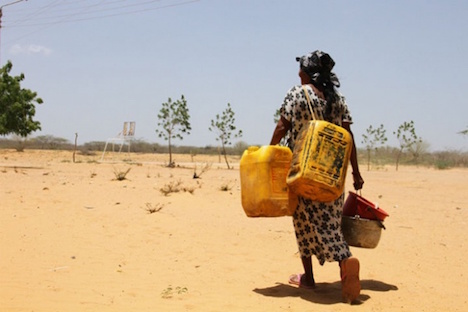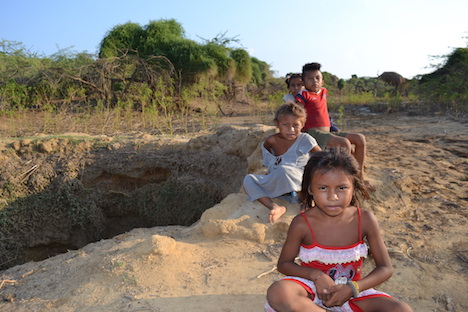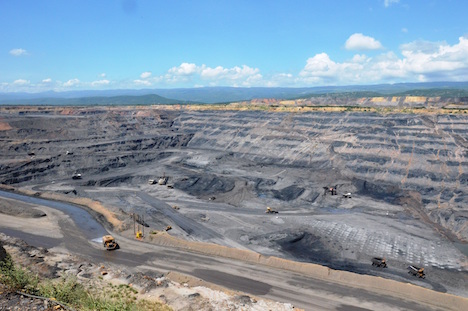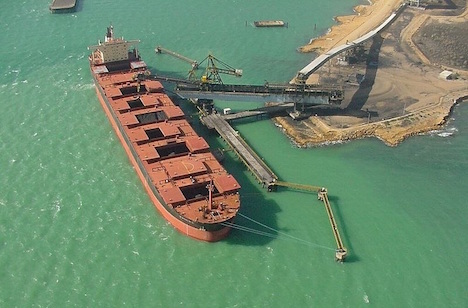|
La Guajira is a Colombian department bordering
Venezuela and encompassing most of the Guajira Peninsula, on the
Caribbean Sea. It is distinguished by desert landscapes, giant sand dunes and
the remote ranches and fishing villages of the indigenous Wayúu people. The capital
city Riohacha has a palm-lined waterfront, beaches and craft stalls, and serves
as the gateway for adventure tourism in the region.
However, behind this image of an indigenous
people living and preserving their millennium culture in their traditional
territory, there is an epidemic of hunger and starvation present affecting
mainly the children of La Guajira.
Just recent two more children from the Wayúu died
from malnutrition in less than a week and this has been an ongoing problem that,
in the words of Javier Rojas, a leader of this indigenous community, “is an
epidemic that is undermining the childhood future of La Guajira”.
There has been no let-up in children’s deaths
from starvation in the Colombian La Guajira. Part of La Guajira runs into
Venezuelan territory where the Wayúu are still poor but thanks to the
socialist policies of the Bolivarian Revolution, tragic cases of starvation and
malnutrition of vulnerable infants has largely been avoided.
On the other hand, Colombia’s neoliberal, free
trade minded government does not provide such effective social safety nets for
the vulnerable Wayúu children and the results are as tragic as they are sad and
hard to bear.
 |
| Water duty in La Guajira |
Reports on this situation have been filed with
the Interamerican Commission on Human Rights (CIDH) and show that in the last
eight years more than 4770 children of this indigenous community have died due
to malnourishment and a lack of drinking water.
In 2015 the representative of the Shipia
Wayúu, Javier Rojas, rejected the numbers mentioned by Colombian president Juan
Manuel Santos concerning the number of Wayúu children dying of malnutrition in
La Guajira. According to Santos only 300 children had died from malnutrition in
the last eight years, which is an attempt to minimize or hide the true scale of
this tragedy. In fact, in a report broadcast today on Radio Del Sur, some
Colombian doctors are saying that the cause of death of many children has been
heart failure and thus do not mention malnutrition.
In an interview Rojas stated that more than 3000
children had died from malnutrition and lack of drinking water according to a
census carried out by indigenous families themselves. Rojas maintains that each
week one or two children are dying from this cause.
For the Wayúu population as whole living in
La Guajira the situation has been complicated by a three year long drought that
shows no sign of breaking. There is little work, most of it temporary and paid
at starvation wage levels and children in the area survive on a glass of chichi
a day plus any extra food drummed up from the temporary work their parents can
find.
According to Javier Rojas there is simply no
work available and no governmental source of food. “In the salt beds, where
there used to be work, the whole area is now being run by foreigners,” he said.
 |
| Child poverty in Colombia's La Guajira |
Last year the Interamerican Commission on
Human Rights (CIDH) asked the Colombian
government to “adopt measures necessary to preserve life and human integrity”
of children and adolescents of the indigenous Wayúu community in the Guajira
municipalities of Uribia, Manaure, Riohacha and Maicao. According to the CIDH
the indigenous “are at risk due to the lack and access to drinking water and
the state of destitution of children living in the community”.
The CIDH also asked the Colombian government
to ensure the ”availability, accessibility and quality of health services
focused on combating infantile malnutrition in the region”.
La Guajira has a population of 846,609 of
which 54.8% live in the towns and 45.2% in rural areas. Almost 45% is
indigenous which represents 20.2% of the total indigenous population of
Colombia.
Unemployment in La Guajira is running at 47%,
which is 300% higher than the national average in Colombia.
Water for coal mining but
not for indigenous communities
In La Guajira policies allow foreign investments to enjoy far more
rights and importance than social policies to protect the population. Mining activities
to extract natural resources do little to stimulate any social development and
on the contrary increase the vulnerability of the inhabitants due to damage to
the environment and the privatization of water resources in the area.
 |
| El Cerrejo - World's biggest open cast coal mine |
El Cerrejón is the world’s largest open cast coal mine. It is located at
the source of the River Ranchería and produces annually 32 million tons of
coal. This exploitation renders a high level of taxes for the country. There is
also a railway consortium for transporting minerals for about 150 km direct to
a sea port where vessels with a capacity of 180 thousand tons are moored.
Cerrejon Coal is owned by three mega mining multinationals listed on the
London Stock Exchange and with offices in London: Anglo American, BHP Billiton
and Glencore Xstrata.
Originally El Cerrejón was seen as the great hope for combating
unemployment in the region, but it has been converted into a camp of human
exploitation. Multinationals that get rich extracting Colombian coal, have been
denounced by the miners for not complying with minimum labor or wage
conditions. Workers mention long shifts under a searing sun; no recognition of
work related illnesses such as silicosis, dehydration and physical injuries as
well as hearing problems - and this is without even mentioning the long hours
laboring in coal dust.
The indigenous community has also denounced the environmental and human
impact that open cast coal mining has caused. They have lost access to the
river as the land has been privatized as well as thousands of hectares of
tribal lands. Nearby settlements suffer from noise, explosions, drilling and
the rail line crossing their territory.
Despite protests there has been little or no response from the Colombian
government to rein in this ongoing destruction of the life of the Wayúu. The
main water source is controlled by the multinationals that run El Cerrejón.
They have desalinization plants, water holding areas and water pumps for their
industrial processes.
At the same time water resources are being denied to the Wayúu causing
misery and death all in the name of the exploitation of natural resources for
monetary gain.
 |
| Loading coal from El Cerrejón at Puerto Bolívar |
Conclusions
Intervention by the CIDH has had little impact and so year after year,
vulnerable Wayúu children are dying unnecessarily. Now, what are you doing with
the taxes you collect from the coal mining carried out at El Cerrejón,
President Santos? Millions of us would like to know.
Do you have no control to curb the anti human rights abuses of Anglo
American, BHP Billiton and Glencore Xstrata who now own the natural resources
of the Colombian people?
And one final thought – imagine the outcry if kids were dying of hunger
in Venezuela as is happening in Colombia. We have enough mud thrown at us
saying our economic model is wrong since people cannot buy the soap powder they
want! God knows what would be said about the economic model if kids were
actually dying in their thousands of hunger. The marines would already be
landing.
The fact little is said in the corporate media about this tragedy of starving kids on La
Guajira must mean that these unethical rags and their
editors believe that the Colombian economic-malnutrition model is just fine.
Arturo Rosales writes from Caracas
© Copyright 2016 by AxisofLogic.com
This material is available for republication as long as reprints include verbatim copy of the article in its entirety, respecting its integrity. Reprints must cite the author and Axis of Logic as the original source including a "live link" to the article. Thank you!
|

